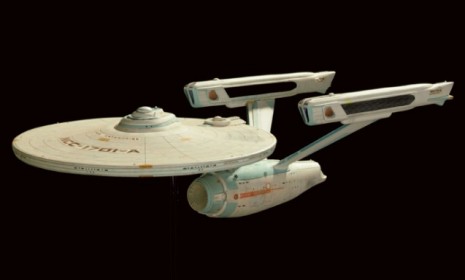Proof that Star Trek's warp drive might actually work?
A NASA scientist claims that he's discovered the key to moving faster than the speed of light — a development that could one day make interstellar travel a reality

Star Trek fans know that the Starship Enterprise zips around the universe — and escapes some seriously hairy situations — with warp drive, a technology that allows Captain Kirk and Co. to move faster than the speed of light. Warp drive may seem far-fetched to some (Mel Brooks once mocked it as "Ludicrous Speed" in his comedy Space Balls), but it's actually related to the theory that space-time, the fabric of space, can be manipulated to allow objects to move faster than photons of light. And now a NASA scientist, Harold White, says he has created a feasible model for warp drive, building on a theory expounded by Mexican physicist Miguel Alcubierre in 1994. Here, a guide to these far-out findings:
What's the history of this warp-drive theory?
Alcubierre was the first scientist to come up with a model for warp drive. Imagine a football-shaped spacecraft attached to a ring that would constantly encircle it. The ring, potentially made of exotic matter (or theoretical particles), would somehow cause space-time to warp. "By creating one of these warp bubbles, the spaceship's engine will compress the space ahead and expand the space behind, moving it to another place without actually moving," says Jesus Diaz at Gizmodo. The problem? The energy needed to warp space equals "the mass-energy of Jupiter," says Shane McGlaun at TechnaBob.
The Week
Escape your echo chamber. Get the facts behind the news, plus analysis from multiple perspectives.

Sign up for The Week's Free Newsletters
From our morning news briefing to a weekly Good News Newsletter, get the best of The Week delivered directly to your inbox.
From our morning news briefing to a weekly Good News Newsletter, get the best of The Week delivered directly to your inbox.
Okay. So what has this NASA scientist discovered?
White says Alcubierre's model would be far more energy efficient with a ring shaped like a rounded doughnut, instead of a flat ring. In addition, White says "the intensity of the space warps can be oscillated over time," further reducing the energy required, says Clara Moskowitz at Space.com. With these adjustments, White says his warp drive can be powered with a "mass about the size of a spacecraft like the Voyager 1 probe NASA launched in 1977." All in all, his warp drive model would move objects at 10 times the speed of light.
How is he testing his theory?
"White and his colleagues have begun experimenting with a mini-version of the warp drive in their laboratory," says Moskowitz. They are using a "laser interferometer" to make miniscule versions of space-time warps, in what White has described as a "tabletop experiment."
A free daily email with the biggest news stories of the day – and the best features from TheWeek.com
Is warp drive really necessary?
Yes! "With our current propulsion technologies, interstellar flight is impossible," says Diaz. And even if scientists could summon the energy to propel a space craft to another star, "it will require decades — centuries even — to get there." If humans are "ever going to become a true spacefaring civilization, we're going to have to think outside the box a little bit," Richard Obousy, president of Icarus Interstellar, tells Space.com.
Sources: Gizmodo, SlashGear, Space.com, TechnaBob, VentureBeat
-
 Political cartoons for December 12
Political cartoons for December 12Cartoons Friday's political cartoons include presidential piracy, emissions capping, and the Argentina bailout
-
 The Week Unwrapped: what’s scuppering Bulgaria’s Euro dream?
The Week Unwrapped: what’s scuppering Bulgaria’s Euro dream?Podcast Plus has Syria changed, a year on from its revolution? And why are humans (mostly) monogamous?
-
 Will there be peace before Christmas in Ukraine?
Will there be peace before Christmas in Ukraine?Today's Big Question Discussions over the weekend could see a unified set of proposals from EU, UK and US to present to Moscow